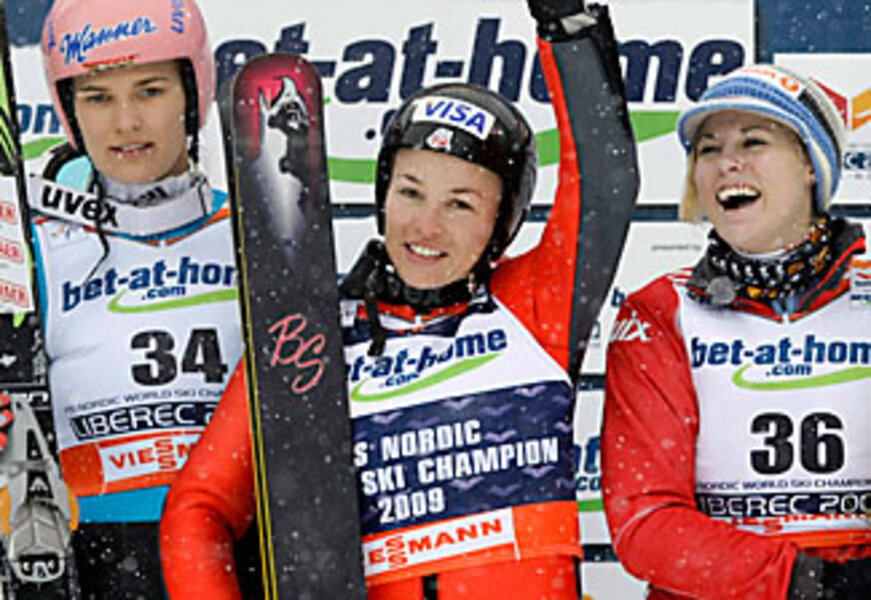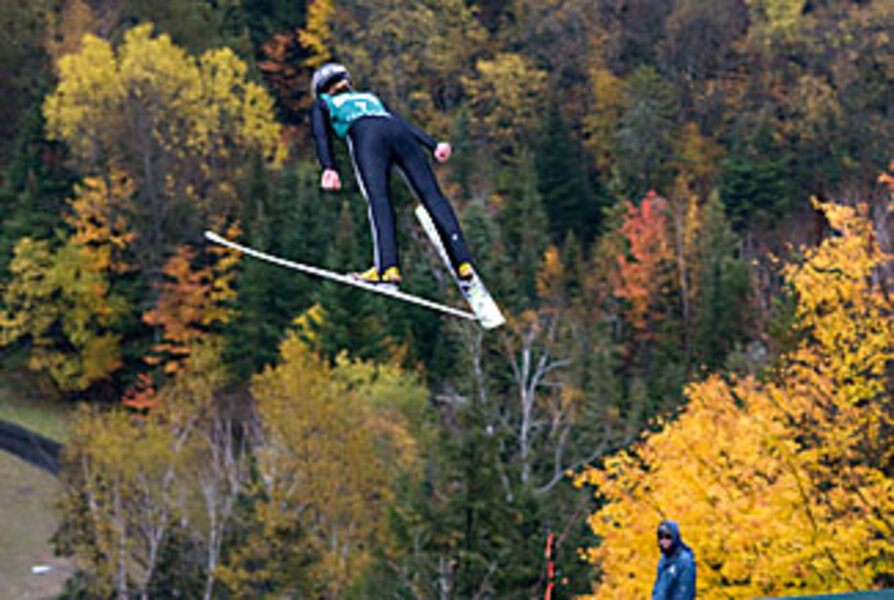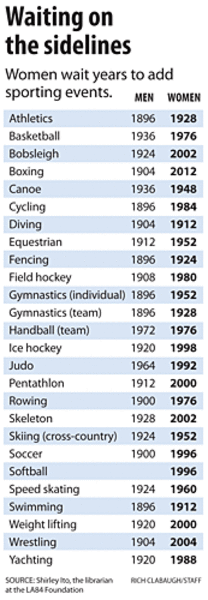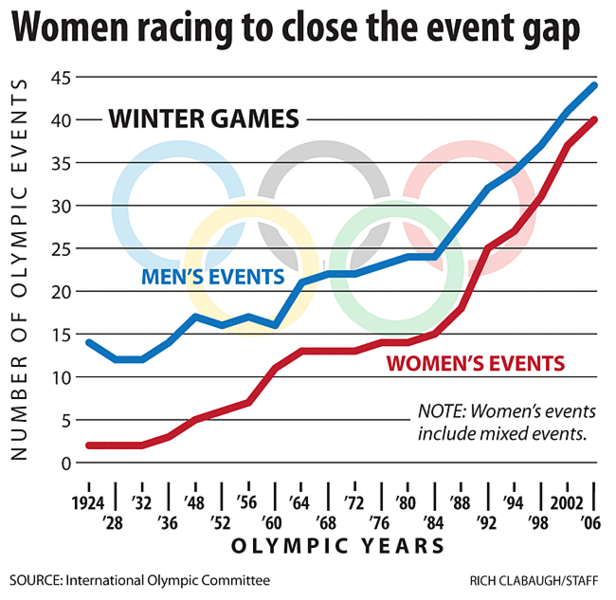Why women can't ski jump in the Winter Olympics
| Lake Placid, N.Y.; and Boston
Unless a Canadian court decides otherwise, the ski jumper with the longest flight on record at Vancouver's Olympic facility will not attend the winter Games in February.
She is not allowed to compete.
Olympic ski jumping is a men's-only domain. Since the first winter Games in 1924, men have been swooping down snowy ramps at 55 m.p.h. and springing into flight – human rockets hurtling chin-first, hands thrown behind, and skis angled forward. With nothing but speed and their skis to aid them, they fly the length of a football field or farther – a feat of technical genius disguised in balletic grace.
But women can do it, too – the best often flying as far as men.
With women now included in such formerly all-male Olympic events as boxing, wrestling, bobsleigh, and luge, the last Olympic door closed to women is ski jumping.
But American ski jumper Lindsey Van – who set the record on the 90-meter jump when the Olympic venue opened in Vancouver, British Columbia, last year and is the reigning world champion – hasn't given up on prying that door open. It's a logical step for the 24-year-old, who, since age 7, has been soaring over Earth's mundane limits on what is possible.
She and more than a dozen other women jumpers from Slovenia to Norway hope to legally force the addition of women's jumping before the Games open Feb. 12. Their lawsuit against the Vancouver Organizing Committee (VANOC) contends that not allowing women to jump for gold is a form of discrimination under Canadian laws that prohibit gender discrimination in government activities.
A Canadian judge, last summer, agreed: It is discrimination.
But her ruling concluded that while VANOC is subject to those antidiscrimination laws, it can't control the events – that's the domain of the International Olympic Committee (IOC). The IOC voted in 2006 against including women's ski jumping in 2010 because it deemed there weren't enough high-level women to create competition worthy of the Olympics. Because the IOC isn't bound by Canadian law, the judge ruled, Canada is powerless to change the program.
So the jumpers' appeal asks Canada to refuse to hold the men's event unless both genders can compete.
When the appeal is heard Nov. 12 and 13, it will highlight not just women's battle to wipe out the last vestige of an old-boys-club Olympic culture, but also competing demands on the Olympic ideal:
•Allowing athletes to pursue success on the most visible world stage.
•Broadening the appeal of the Games among Gen-Xers interested in more extreme sports while keeping costs manageable.
•Satisfying TV, a key sponsor.
"IT'S A TEXTBOOK CASE OF DISCRIMINATION," says Anita DeFrantz, chair of the IOC's Women and Sports Commission. "This group of athletes is being told that they're not good enough, that there aren't enough women in the top level.... That's never been an issue before."
The IOC defends its position as preservation of the Olympic standard, saying the top women jumpers don't deserve the same gold that is awarded to figure skaters and alpine skiers who have risen to the top of far larger fields.
But the IOC's recent record of admitting both women's events (see chart) and disciplines with weak fields – such as bobsleigh and ski cross – suggests the issue is not as clear-cut as either side asserts.
More than 80 years after men's ski jumping debuted as one of six original Olympic sports, the International Ski Federation (FIS) – which stages ski events at the Olympics – voted in 2006 to recommend women's jumping for inclusion in the 2010 Games. The federation endorsed women's ski cross over ski jumping. Neither sport fully met the IOC criteria for inclusion. The IOC only approved ski cross, which had the required two world championships but less than half as many elite women as ski jumping. Men's ski jumping doesn't meet the criteria either, but was grandfathered in. Compounding suspicions of gender discrimination was the fact that FIS president Gian Franco Kasper told National Public Radio in 2005 that jumping was too dangerous for women, that it "seems to be not appropriate for the ladies from a medical point of view."
But Walter Sieber, a Canadian member of the IOC division that recommended not to include women's ski jumping in the 2010 Games, denies that the decision had anything to do with gender – pointing to the IOC's decision this year to include women's boxing as evidence of the IOC's true colors.
While he admits that the top women jumpers are very competitive, he maintains that there aren't enough competitors at that level to warrant an Olympic sport.
The 2009 World Championships results support that view: The women's field of 36 had a 20-point gap between top competitors and weaker ones, while the men's field of 50 competitors finished closer together.
THE BOTTOM LINE, claim both those alleging and denying sex discrimination, is the hard fact that the multibillion-dollar Olympic machine is subject to the rising pressure of commercialism.
"What matters to the IOC is: Will the event sell tickets, will it sell TV time, is it popular?" asserts Jacqueline Hansen, a runner who was a member of the lobby that won a place for the women's marathon in the 1984 Olympics.
Since then, the sway of TV has become so great that Michael Phelps swam at 6 a.m. in Beijing – prime time in the US. TV may well have played into the IOC's decision to approve women's ski cross events for the 2010 games. A sort of motocross on snow, the sport is a variation on snowboard cross – an event introduced in the 2006 Torino Games that was a hit with NBC, which paid $1.5 billion for TV rights there and in Beijing.
Olympic officials do consider TV appeal in deciding on sports, confirms Mr. Sieber. In the era of IOC president Juan Antonio Samaranch, in the 1990s, he says, the emphasis was "to have many sports involved," but the expanding Games became unwieldy for organizers. In the current era, the bar for new events is higher – they must be "good for TV" and "an addition that enhances the program."
AMERICAN SKI JUMPER JESSICA JEROME, fresh from winning the US Nationals in Lake Placid, N.Y., last month, says she understands the commercial pressures on the IOC: "The Olympics for so long has been what Mom and Dad sit down to watch while the kids are out skateboarding or snowboarding – doing these things that are radical and rebellious."
But while she acknowledges that X-Games sports will increase viewership and revenue – benefiting all Olympic sports, ski jumping is no less daring. "I think it's one of the most ex-treme sports ... it's got that dangerous element, but it's also got that beautiful, elegant thing to it," she says.
BUT WHILE THE WOMEN jumpers recognize the need to grow the sport, they say they face discrimination at every level – a point supported by a 2009 book by Western European sports scholars, "Sport and Gender Matters in Western Countries."
"Barred from serious competition for decades because jumping was not deemed appropriate for females, women ski jumpers have not been able to establish the appropriate experience in international level training and competition and to gain the type of 'technical merit' required...." concluded a chapter on ski jumping that also notes women were jumping as early as the 1920s.
"Jumping is a very traditional European old-men type of sport. They think that women will take away the extremeness of it," says Ms. Jerome,
Women jumpers got their first international circuit in 2004, and were allowed to compete at world championships for the first time last year. But in a sport in which the best European men are treated like rock stars and pocket roughly $10,000 per win, the women are only allowed to compete on a secondary circuit that awards winners $500. And, says Ms. Jerome, women are treated very differently. She and her teammates have eaten meals with barn cats jumping on the table and slept above livestock stalls in lodging arranged by competition organizers.
Even after Ms. Van won world championships last year, the US Ski Team – facing an 18 percent budget cut – dropped all funding for women's jumping, and men's, too.
THE BRITISH COLUMBIA Court of Appeal must now decide whether VANOC should refuse to hold men's ski jumping unless women are allowed to compete.
VANOC attorney George McIntosh argued before Judge Lauri Ann Fenlon that as host, VANOC implements, but can't control, the Olympic program. And while she ultimately found in VANOC's favor, she put his argument into stark relief when she asked Mr. McIntosh if VANOC would plead the same point if blacks weren't allowed to compete in the Vancouver Olympics. His answer, after an awkward silence, was yes.
VANOC has encouraged the IOC to include women's ski jumping, and if that happened, officials say, the Vancouver machine would be able to accommodate the women.
Without that action at the IOC level, however, no one is sure what to expect if the court upholds the women's appeal.
"It's unprecedented," says McIntosh, who half jokes that to enforce such a ruling, "[The VANOC chief] would have to be standing at the top of the jump with a bayonet." •








